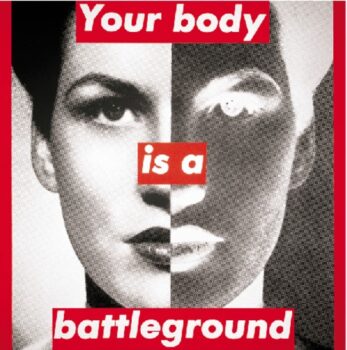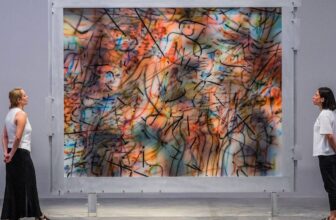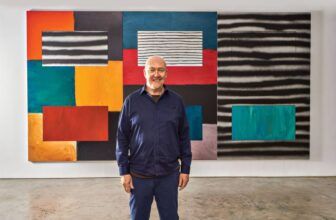What Was Barbara Kruger Known For
In a world saturated with images, advertisements, and relentless noise, few artists have managed to arrest the public’s attention as effectively, and critically, as Barbara Kruger. With bold red, black, and white text that seems to shout from gallery walls and billboards alike, Kruger’s art dissects consumer culture, identity politics, and gender dynamics with surgical precision. Her work is instantly recognizable, yet endlessly layered in meaning. For over four decades, she has stood as a defiant voice in the art world, bridging the gap between visual art, activism, and graphic design.
Barbara Kruger is best known for her provocative text-based works that combine black-and-white photographs with declarative captions, often set in white Futura Bold Oblique text on red backgrounds. Her most iconic phrases, “Your body is a battleground,” “I shop therefore I am,” “You are not yourself”, have become synonymous with the critique of mass media and power structures.
Kruger’s work confronts issues of identity, control, consumerism, feminism, and propaganda. It is often described as conceptual and postmodern, drawing from semiotics, feminism, and Marxist theory. Unlike many traditional artists, Kruger’s primary medium is language, and her canvas is often public space. Billboards, bus stations, magazine covers, t-shirts, and digital projections, these are all part of her domain.
She is not just critiquing culture; she is interrogating it. Her art holds a mirror to the systems of power that define society: gender roles, capitalism, surveillance, and media manipulation. Her visual language is so influential that it’s even been co-opted by commercial brands and meme culture, sometimes unwittingly referencing the very systems Kruger set out to critique.
The Story Behind the Artist: Barbara Kruger’s Rise
Barbara Kruger was born in 1945 in Newark, New Jersey. She studied at Syracuse University and the Parsons School of Design in New York City. Early in her career, Kruger worked as a graphic designer and art director for Condé Nast, particularly Mademoiselle magazine. This background in magazine layout and advertising became the bedrock of her artistic aesthetic.
By the late 1970s, Kruger had grown disillusioned with traditional art-making, shifting away from painting and photography to begin experimenting with photomontage and text. She adopted the aesthetics of advertising and mass media, mediums typically used to sell and seduce, and twisted them into tools of critique and resistance.
This pivot allowed her to develop the distinctive style that would come to define her work: emotionally charged, politically provocative, and visually arresting. By the 1980s, Kruger had emerged as a major voice in the contemporary art scene, aligning with other feminist artists like Jenny Holzer and Cindy Sherman, though her voice and visual style remained utterly singular.
How Famous Is Barbara Kruger?
Barbara Kruger is one of the most famous and influential contemporary artists in the world. Her work has been exhibited in major museums and institutions globally, including the Museum of Modern Art (MoMA) in New York, the Whitney Museum, the Tate Modern in London, and the Los Angeles County Museum of Art (LACMA).
She represented the United States at the Venice Biennale in 2005 and has received numerous prestigious awards, such as the Golden Lion for Lifetime Achievement at the Venice Biennale in 2021. She has also taught at major institutions, including UCLA and CalArts, shaping generations of artists.
In popular culture, Kruger’s impact is undeniable. Her influence can be seen in streetwear brand Supreme’s logo (which mimics her red-and-white aesthetic), countless online memes, protest posters, and even political campaign imagery. While Kruger herself has criticized the commercial co-option of her style, its ubiquity is a testament to the power and relevance of her visual language.
In the digital age, where image and text are consumed in rapid-fire swipes, Kruger’s art resonates even more intensely. Her succinct, charged phrases read like prophetic slogans in a world struggling with misinformation, commodification, and social unrest.
How Does Barbara Kruger Make Her Artwork?
Kruger’s process is both conceptual and technical. At its core, her artwork is rooted in language. She starts by crafting short, impactful phrases, often pronouncements or questions, that directly engage the viewer. These phrases are steeped in irony, satire, or confrontation, designed to elicit self-reflection or critique of broader societal norms.
Visually, she uses black-and-white photographs, often sourced from old magazines or archival images, that she overlays with her bold text. The images serve as a kind of visual bait, drawing the viewer in before the words deliver their pointed message.
In earlier years, Kruger physically assembled her works by cutting and pasting text over photocopied images, later photographing the final composition. With technological advancements, she now uses digital tools to create large-scale vinyl prints, video installations, and even immersive environments.
For site-specific installations, Kruger transforms entire spaces, walls, floors, ceilings, into immersive textual experiences. Her 2022 exhibition Thinking of You. I Mean Me. I Mean You. at LACMA, for example, included entire rooms wrapped in her iconic red-black-white text, creating an overwhelming sensory and intellectual experience.
Kruger also works across mediums: video, digital art, public installations, sound, and LED displays. Her agility across platforms is a deliberate strategy to embed critical discourse in everyday life, on walls, in newspapers, on subways, and on the internet.
How Much Does Barbara Kruger’s Art Cost?
Barbara Kruger’s artworks are highly valuable, both culturally and economically. While exact prices vary depending on the work’s size, medium, and provenance, her pieces have fetched significant sums at auction.
Her limited-edition prints and photographs typically range from $20,000 to $200,000. More rare or large-scale works, particularly unique pieces, can exceed these figures. For example, her piece “Untitled (Your Manias Become Science)” sold for over $600,000 at auction.
However, it’s worth noting that Kruger herself is deeply critical of the art market’s commercialization. Much of her work is non-commercial by design, created for public spaces, freely distributed as posters, or printed on cheap materials. This is part of her broader philosophy: to democratize art and confront the elitism of the gallery system.
Nevertheless, the demand for her work remains strong among collectors and institutions, and she remains a key figure in art market circles.
How Many Artworks Does Barbara Kruger Have?
Quantifying Barbara Kruger’s total body of work is challenging due to the diversity of her output and the ephemeral nature of many of her installations. She has created hundreds of unique pieces, including:
Photomontages
Video and multimedia installations
Site-specific installations
Public art (billboards, bus stops, subway ads)
Magazine covers and posters
Digital projections and LED displays
Some of her most iconic series, like Untitled (Your Body is a Battleground) (1989), have appeared in numerous versions and formats. Her artworks are held in major collections around the world, including the Guggenheim, MoMA, Tate, and Centre Pompidou.
Kruger’s output is prolific not just in quantity but in influence. Every new installation or exhibition she creates often sparks renewed discourse about feminism, capitalism, and media literacy.
What Art Style Is Barbara Kruger Associated With?
Barbara Kruger is most closely associated with Conceptual Art, Feminist Art, and Postmodernism.
Conceptual Art: Kruger’s work prioritizes ideas over aesthetics. The “concept” behind her work, the critique of societal structures, is its central force.
Feminist Art: Kruger emerged during the rise of second-wave feminism, and her work continually interrogates gender roles, female representation, and the politics of the body.
Postmodernism: Kruger’s use of appropriation, irony, intertextuality, and visual pastiche are hallmarks of postmodern artistic sensibilities.
She also draws from Dada and Pop Art, particularly in her use of mass media imagery and typography. But unlike Warhol, who celebrated consumerism, Kruger deconstructs and subverts it.
What Materials Does Barbara Kruger Use?
Barbara Kruger uses a range of materials depending on the context and format of her work. These include:
Photographs: Typically black-and-white, often appropriated from 1950s-60s magazines or archival sources.
Text: Set in Futura Bold Oblique or Helvetica, often white text on red bars.
Vinyl: For wall texts and large-scale installations.
LED Displays: For moving text installations.
Audio and Video: Used in immersive installations, often featuring spoken word or monologues.
Digital Prints: For editioned works and gallery exhibitions.
Site-specific Media: Paint, wallpaper, and architectural wraps for exhibitions that take over entire buildings or spaces.
Her choice of materials underscores the industrial, mass-produced feel of her work, a deliberate nod to the ubiquity and impersonality of modern media.
Why Barbara Kruger Matters Today
Barbara Kruger’s art has never been more relevant. In an age of surveillance capitalism, fake news, algorithmic bias, and political polarization, her incisive phrases continue to cut through the noise. Her works pose questions we’re still grappling with:
Who controls the narrative?
What does it mean to consume, to conform, to resist?
How are we complicit in systems of oppression?
Her use of direct address, you, we, they, implicates the viewer, collapsing the boundary between observer and subject. She forces us to look inward as we look outward.
Kruger’s art is not just seen; it is read, heard, and felt. It challenges, provokes, and endures.
Barbara Kruger is not simply an artist; she is a cultural force. Her art occupies a space between protest and poetry, between graphic design and philosophical inquiry. With a few carefully chosen words and a stark visual style, she has managed to dissect the most tangled questions of identity, power, and truth in the modern world.
Whether installed in the hallowed halls of MoMA or on the side of a public bus, Kruger’s work insists that we pay attention, not just to her art, but to the world it reflects.
In a society awash with manipulation and distraction, Barbara Kruger offers clarity. Not by simplifying the world, but by distilling its contradictions into unforgettable messages.
And in those messages, so simple, so sharp, we find not just critique, but the possibility of awareness. And perhaps, change. image/wikiart.org




